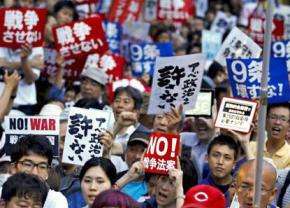Japan’s summer of protest
Australian socialist reports on the issues animating a surge in anti-government protests in Japan, in an article first published in Red Flag.
JULY THROUGH September 2015 will be remembered in Japan as the summer of protest. The target was Prime Minister Shinzo Abe's security law, which gives the country's military a stronger role globally. Legislation passed the upper house in the early hours of September 19. For some, that day marks the "death of democracy." For others, the democracy of the street has been revitalized.
Mass protests prior to the legislation passing contained placards reading, "Scrap the war bills," "No to war," "Leave Article 9 alone" and "Abe, quit." In the hours after the legislation passed, people created placards demanding, "Kick the fascists out."
The largest demonstration occurred on August 30, when an estimated 300,000 people gathered outside the Diet, Japan's parliament. On July 15, 60,000 people turned out. Expressions of anger on this scale haven't been seen since the 2011-12 anti-nuclear demonstrations, which were prompted by the reopening of nuclear reactors that had been shut down after the Fukushima disaster. The size of the rallies is surprising because mass demonstrations in Japan have been rare in the last 40 years.

The protests were reminiscent of May 1960, when hundreds of thousands of protesters surrounded the Diet opposing Prime Minister Nobusuke Kishi, Abe's grandfather, who was forcing through a revised Japan-U.S. security treaty. Kishi got the treaty through, but the surrounding furor forced his resignation.
Abe is unlikely to resign, but his popularity is suffering. His approval rating is at 36 percent--down from 63 percent in January 2013, soon after he was elected with a two-thirds majority. Anger with Abe's government has been building since the election.
Unable to get the two-thirds majority needed to amend Article 9--the peace clause of the constitution--Abe opted to introduce legislation reinterpreting it. The changes allow Japan's military to fight abroad for the first time since the Second World War.
Everyone knew that the legislation would pass because Abe's Liberal Democratic Party controls the upper house. Yet people still mobilized to voice opposition to the legislation. A recent Asahi newspaper poll reported that 54 percent of the population oppose the legislation.
Thousands have rallied every Friday night in Tokyo, and on some weekends as in other major cities throughout the country. The protests have drawn in a wide spectrum of people of all ages and with a range of political views--Christian groups, local housewives associations, left wing groups, unions and the student organization Zengakuren. In the past week, truck drivers and dockworkers took strike action to protest both the legislation and the construction of the new U.S. military base in Okinawa.
The protests have also invigorated a new layer of activists. A group formed by high school and university students has exploded onto the scene. Student Emergency Action for Liberal Democracy (SEALD), which emphasizes that it is unaffiliated with any political groups, has taken the lead in organizing, publicizing and leading the demonstrations. Women are playing a prominent role.
The demonstrations have tapped into much broader concerns, which SEALD also shares, about growing inequality, cuts to social welfare, the fate of those on low incomes and the homeless, a decline in reliable stable employment, especially for young people and the reopening of nuclear power plants.
First published at Red Flag.


